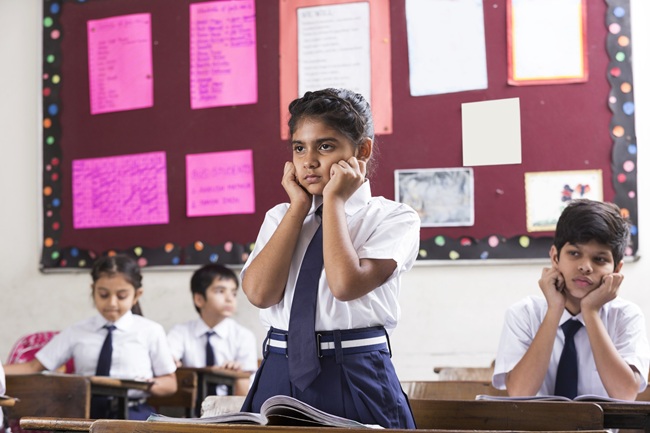Dec 11, 2025
Dec 11, 2025
by Renu Dhotre
Discipline is not the absence of freedom. It is the presence of guidance.

In the rapidly evolving landscape of education, one timeless value remains central to nurturing young minds—discipline. Often misunderstood as a rigid set of rules, discipline in its true essence is about structure, self-regulation, and fostering an internal compass that guides students through life with purpose, responsibility, and respect.
What Is Discipline?
Discipline is more than punishment or enforcement—it is a system of values, habits, and routines that shape an individual’s character. It instills time management, responsibility, cooperation, and emotional regulation. It is seen not just in silent classrooms or orderly lines, but in how a student manages their time, interacts with others, resolves conflicts, and reflects on their behavior.
Where Do We Find Discipline?
Discipline is all around us:
• In nature’s cycles—sunrise and sunset, seasons, tides.
• In professional environments—deadlines, conduct codes, roles.
• In sports—team rules, fair play, consistent training.
• In homes—routines, cultural practices, respect for elders.
However, in schools, discipline needs to be consciously cultivated to balance the inconsistencies students face between home, society, and school expectations.
The Problem of Inconsistency
One major challenge is the disconnect between the discipline norms at home, outside world, and the school environment. At home, students may have flexible or no routines; outside, they are bombarded with distractions, and in school, they are expected to behave, sit quietly, and follow strict codes—often without understanding why.
This dissonance confuses students. Therefore, schools must become safe spaces with clear, consistent structures across all classes and teachers. When every teacher follows a common code, discipline becomes predictable, fair, and acceptable.
Why Discipline Matters
Good discipline fosters:
• Academic achievement
• Emotional resilience
• Empathy and peer respect
• Time consciousness
• Leadership and responsibility
On the contrary, poor or inconsistent discipline leads to:
• Classroom disruptions
• Absenteeism
• Bullying
• Emotional distress
• Resistance to authority
Transforming Discipline: From Fear to Flourishing
Traditional models of discipline relied heavily on control and punishment. Today, the paradigm is shifting toward constructive, engaging, and empathetic practices rooted in peace education, social-emotional learning, and mindfulness.
Innovative School Strategies for Discipline
Here are research-informed and field-tested approaches schools can implement:
1. Structured Break Time (Peace Circles)
For younger grades, structured break times are vital. For instance, students can sit in a circle and eat their food together without moving. After eating, supervised games such as clapping games or mindful movement can follow. This builds routine, community, and a calming rhythm, reducing chaos post-recess.
2. Peace Education: Inspired by Panchgani Models
At a school in Panchgani, students engage in “silent service.” One class washes another’s eating vessels—divided into teams for soaping, rinsing, drying—all done in silence. This builds humility, gratitude, and cooperation.
Another practice includes a fifteen minutes silent walk followed by meditation. These routines encourage mindfulness, regulate emotions, and instill self-discipline without enforcement.
3. Life Skills Integration
Integrate life skills into the curriculum to ensure joyful and responsible learning. Modules can include:
• Conflict resolution games
• Team-building exercises
• Journaling and reflective tasks
• Role plays on empathy and safety
These build intrinsic motivation to behave and connect discipline to real-world needs.
4. Empowered Student Councils
Instead of monitoring only by teachers, train student councils in peer mediation, leadership, and discipline support. Give them responsibilities in break-time monitoring, classroom transitions, and event organization. This builds accountability and mutual respect.
5. Consistent Routines Across Staff
Every teacher should agree upon and follow a common school-wide discipline framework—right from greeting students, handling latecomers, lunch practices, transitions, and even emotional support. This sets clear expectations.
6. Know Your Child (KYC) System
Teachers should maintain and update ‘Know Your Child’ forms, noting the student’s emotional, social, and behavioral progress. With regular updates, teachers become more attuned to changes and can offer personalized discipline and support.
7. Art Therapy and Johari Window Activities
Using art therapy, storytelling, and tools like the Johari Window, students can explore their feelings, understand how others perceive them, and develop self-awareness. These mental engagements reduce disruptive behavior and enhance emotional regulation.
8. Parental Workshops and Community Involvement
Parents often unknowingly undo school discipline through inconsistent home expectations. Workshops should educate parents on school rules, the importance of structure, and how to create consistent boundaries at home. When the school and home work together, discipline becomes a shared value.
9. Emergency Drills and Transitions
Teachers should guide students in transitions—from one class to another, or while leaving school premises. Practice evacuation drills and structured dismissal routines to foster awareness and calm in emergencies.
Final Thoughts: Discipline as Nurture
Discipline is not the absence of freedom. It is the presence of guidance. It is about creating spaces where children can thrive, not merely conform. When schools foster discipline through structured yet joyful and empathetic means, students not only behave—they flourish.
Discipline is the bridge between chaos and creativity, and it is our shared responsibility—as educators, parents, and community members—to ensure that bridge is strong, inclusive, and kind.
Image (c) istock.com
02-Aug-2025
More by : Renu Dhotre